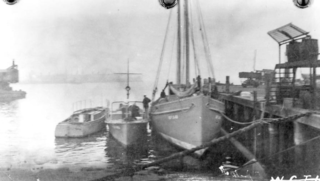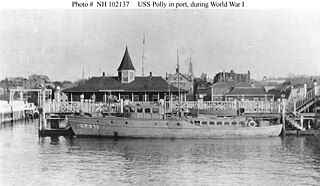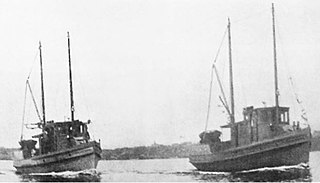U.S. Bureau of Fisheries
The Bureau of Fisheries reported that the Navy transferred Halcyon back in good condition, but also that she was not fully complete or equipped at the time of her 1917 transfer to the Navy and that she needed additional work before she was ready for BOF service. [4] This included the removal of a heavy gun platform the Navy had installed on her forward deck, an overhaul of her engine and other machinery, interior alterations, and the installation of bilge keels, electric lighting, and a dredging winch.
Finally ready for fishery service, USFS Halcyon made her first scientific cruise in August 1920; conducted at the request of fishing interests in Massachusetts, the cruise covered 1,000 nautical miles (1,900 km; 1,200 mi) of fishing grounds in the Gulf of Maine and to the south and southwest of the South Shoal Lightship in an unsuccessful attempt to locate schools of mackerel. [5] She then made two oceanographic cruises in the Gulf of Maine under the direction of Dr. Henry B. Bigelow, the first in December 1920–January 1921 and the second in March 1921, steaming a combined total of 1,286 nautical miles (2,382 km; 1,480 mi) between Cape Cod, Massachusetts, and Nova Scotia, Canada. [5] Based at the BOF's Boothbay Harbor station from July to October 1921, [6] she underwent an overhaul in July and August 1921. [5] With it completed, she made a 1,243-nautical-mile (2,302 km; 1,430 mi) cruise between Nantucket, Massachusetts, Browns Bank, and Yarmouth, Nova Scotia, Canada, to collect bottom samples in support of a hydrographic survey of the Gulf of Maine. [6]
In October 1921, Halcyon's home port changed to the BOF station at Woods Hole, Massachusetts. [6] She towed the BOF vessel USFS Widgeon from Woods Hole to Hampton Roads, Virginia, arriving there on 25 November 1921. [7] [note 6]
During March and April 1922, Halcyon was at Newport, Rhode Island, spending little time at sea but conducting work in support of flatfish studies by the Woods Hole station. [6] She spent June 1922 preparing for a cruise to study currents, and by 30 June 1922 had steamed a total of 3,920 nautical miles (7,260 km; 4,510 mi) over the preceding year. [6] On 30 June 1922 she got underway from Woods Hole [6] and conducted a cruise during which she made observations of currents on lines extending 150 nautical miles (280 km; 170 mi) from Sandy Hook, Connecticut, 150 nautical miles (280 km; 170 mi) from Chatham, Massachusetts, and 25 nautical miles (46 km; 29 mi) from Cape Elizabeth, Maine. [8] During August and September 1922, her crew overhauled the BOF fishery patrol vessel USFS Kittiwake. [8]
In February 1923, Halycon provided valuable service in keeping channels open through ice in the harbors of Gloucester, Manchester-by-the-Sea, and Salem, Massachusetts, [8] and from April through June 1923, she tagged codfish near Nantucket. [8] By 30 June 1923, she had steamed 3,575 nautical miles (6,621 km; 4,114 mi) over the preceding year. [8]
During fiscal year 1924, which ran from 1 July 1923 to 30 June 1924, Halcyon again tagged codfish during the summer months. [9] She also used drift bottles to study currents on 25-nautical-mile (46 km; 29 mi) lines running offshore from Mount Desert and Cape Elizabeth, Maine, and Cape Ann and Cape Cod, Massachusetts, [9] and conducted two short cruises to observe water temperatures in Massachusetts Bay. [9]
During fiscal year 1925 (1 July 1924–30 June 1925), Halcyon steamed 5,143 nautical miles (9,525 km; 5,918 mi). [10] Although she devoted the winter of 1924–1925 to fish-culture work in support of the BOF fish hatchery at Gloucester, Massachusetts, she spent much of the rest of the fiscal year investigating fisheries in the Gulf of Maine, [10] operating from Nantucket Shoals to Mount Desert, Maine. Most of her work during the fiscal year involved tagging cod, haddock, and pollack to gain data on their migrations, and her crew and embarked scientists tagged 16,000 fish during the fiscal year. [10] However, she also made some temperature observations and collected shore fishes. [10]
Halcyon continued her fishery investigations in the Gulf of Maine during fiscal year 1926 (1 July 1925–30 June 1926), working in concert with the BOF research vessel USFS Gannet and steaming nearly 3,000 nautical miles (5,600 km; 3,500 mi). [11] She interrupted this work in February 1926 to visit Portsmouth Navy Yard in Kittery, Maine, where her crew reconditioned the newly acquired BOF research vessel USFS Albatross II. [11]
Fiscal year 1926 turned out to be Halcyon's last year of active BOF service. By the time Albatross II began operating for the BOF in August 1926, taking up Halcyon's former duties in and around the Gulf of Maine, the BOF had laid up Halcyon. [12] Deeming her to be "well built" but of "peculiar design" and no longer suited to BOF requirements, the BOF condemned and sold her in November 1927. [13]



















